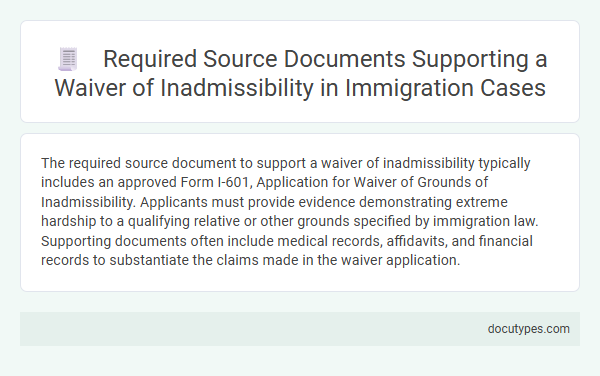The required source document to support a waiver of inadmissibility typically includes an approved Form I-601, Application for Waiver of Grounds of Inadmissibility. Applicants must provide evidence demonstrating extreme hardship to a qualifying relative or other grounds specified by immigration law. Supporting documents often include medical records, affidavits, and financial records to substantiate the claims made in the waiver application.
Introduction to Waiver of Inadmissibility
A waiver of inadmissibility allows certain individuals to overcome specific grounds that would otherwise prevent entry into the United States. Establishing eligibility requires submitting a source document that proves the hardship or eligibility criteria are met.
The required source document varies depending on the reason for inadmissibility, such as criminal history, health issues, or immigration violations. Commonly accepted documents include medical records, police certificates, court dispositions, and affidavits demonstrating extreme hardship to qualifying relatives. Proper documentation is critical for USCIS or the Department of State to evaluate the waiver request accurately.
Importance of Supporting Documentation
Supporting documentation is crucial for a waiver of inadmissibility to verify eligibility and substantiate claims. Required source documents often include medical records, financial statements, and affidavits demonstrating hardship or rehabilitation. Accurate and comprehensive evidence strengthens the waiver application, increasing the likelihood of approval.
Identity and Civil Status Documents
To support a waiver of inadmissibility in immigration cases, applicants must provide clear and verifiable source documents confirming their identity and civil status. These documents play a crucial role in establishing eligibility and ensuring accurate record verification throughout the waiver process.
- Passport - A government-issued passport serves as the primary international identity document confirming nationality and personal details.
- Birth Certificate - An official birth certificate is essential to verify birth details and establish familial relationships and nationality.
- Marriage Certificate - A certified marriage certificate authenticates marital status, critical in cases requiring spousal eligibility verification.
Providing these official documents is fundamental to successfully demonstrating identity and civil status when applying for a waiver of inadmissibility.
Evidence of Family Relationships
Evidence of family relationships is essential to support a waiver of inadmissibility in immigration cases. Proper documentation proves the qualifying family ties required for the waiver application.
- Birth Certificates - Official birth certificates establish parent-child relationships critical for waiver eligibility.
- Marriage Certificates - Valid marriage certificates confirm spousal relationships to support family-based waiver claims.
- Adoption Decrees - Legal adoption documents demonstrate legitimate family connections recognized by immigration authorities.
Medical Records and Health-Related Waivers
Medical records are essential source documents to support a waiver of inadmissibility based on health-related grounds. These records must provide detailed evidence of the medical condition that led to the inadmissibility determination.
Health-related waivers require comprehensive documentation from licensed healthcare professionals. Your waiver application should include diagnosis, treatment plans, and prognosis to demonstrate eligibility for the waiver.
Proof of Hardship to Qualifying Relatives
The required source document to support a waiver of inadmissibility must include detailed proof of hardship to qualifying relatives, such as U.S. citizens or lawful permanent residents. Common documents include medical records, financial statements, and expert affidavits demonstrating emotional, financial, or medical hardship. These documents establish the severity of hardship faced by the relatives if the waiver is not granted.
Financial and Employment Documentation
| Required Source Document | Description | Purpose |
|---|---|---|
| Recent Tax Returns | Federal income tax returns from the past three years | To demonstrate stable income and financial responsibility |
| Employment Verification Letter | Official letter from current employer stating job title, salary, and duration of employment | To verify ongoing employment and financial stability |
| Pay Stubs | Copies of recent pay stubs, typically from the past three months | To provide proof of consistent earnings |
| Bank Statements | Statements from checking and savings accounts over the past six months | To show financial liquidity and ability to support family members |
| Proof of Assets | Documents such as property deeds, investment statements, or retirement accounts | To illustrate additional financial resources |
Criminal Records and Court Dispositions
The required source document to support a waiver of inadmissibility often includes certified criminal records and court dispositions. These documents must be official and obtained from the appropriate jurisdiction to verify case details accurately.
- Certified Criminal Records - Provide a complete history of arrests and charges relevant to the waiver application.
- Court Dispositions - Show the final outcome of all criminal cases, including convictions, dismissals, or acquittals.
- Official Documentation - Must be issued by the court or law enforcement agency to ensure authenticity and acceptability.
Evidence of Rehabilitation and Good Moral Character
What is the required source document to support a waiver of inadmissibility regarding evidence of rehabilitation and good moral character? The primary document typically includes affidavits from employers, community leaders, or religious figures attesting to your good moral character and rehabilitation efforts. Police clearance certificates and proof of participation in rehabilitation programs also serve as critical supporting evidence.
What Is the Required Source Document to Support a Waiver of Inadmissibility? Infographic

